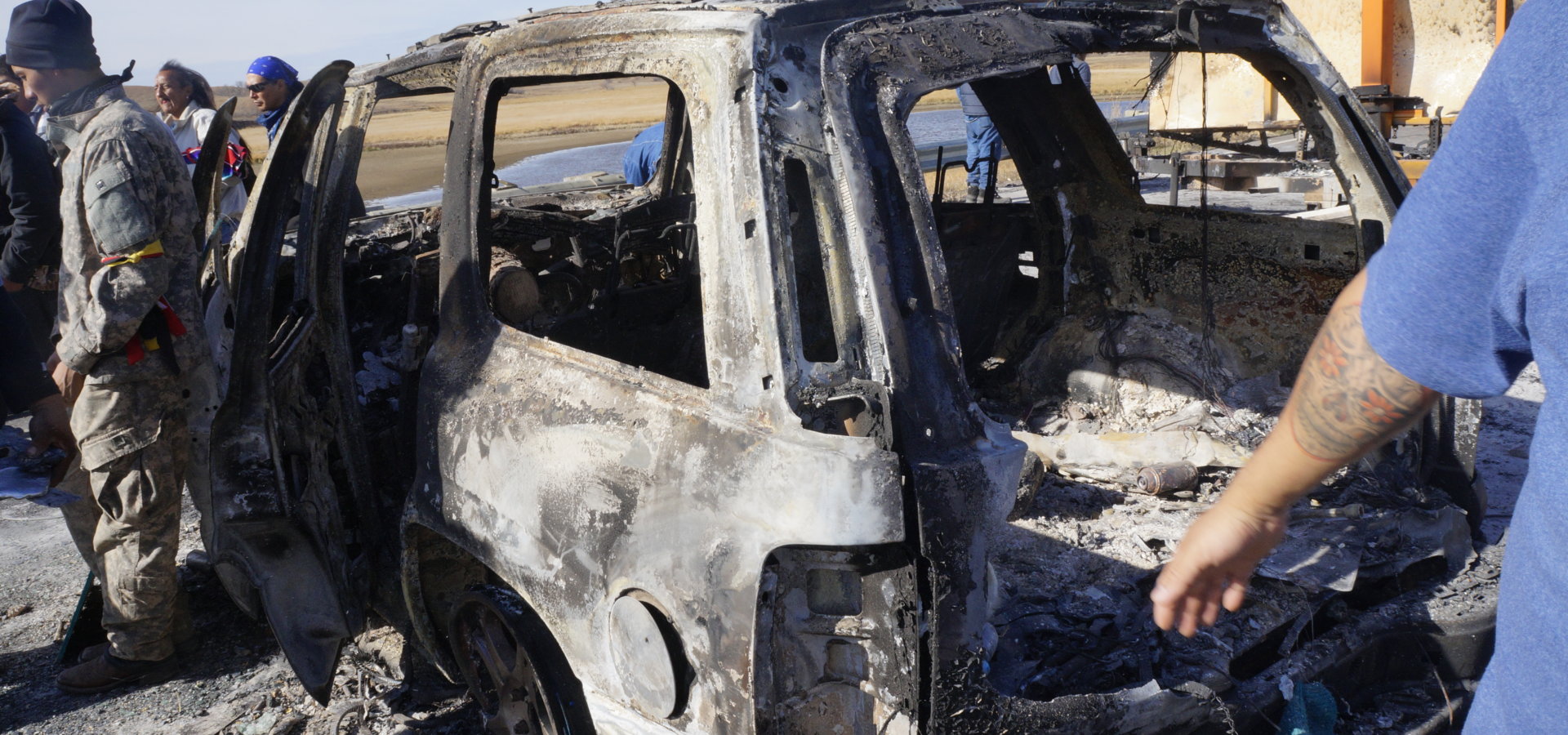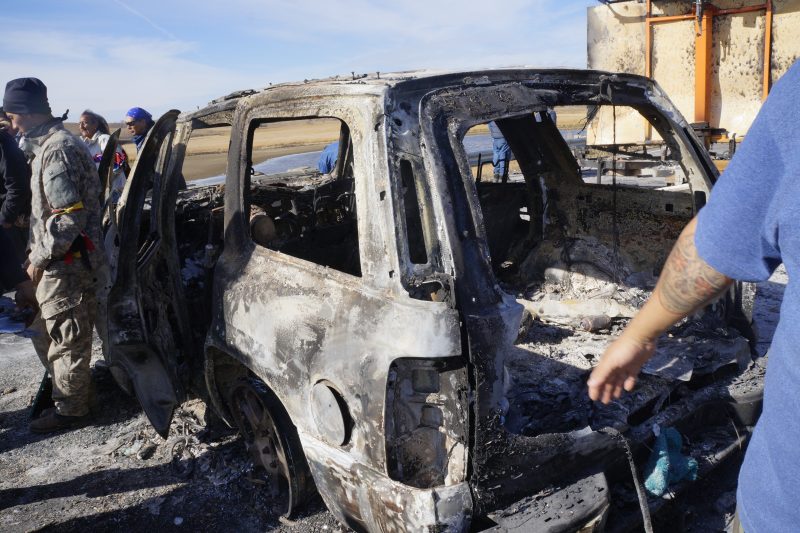
STANDING ROCK SIOUX RESERVATION, North Dakota — Police violence has escalated and destructive forces have entered the fray in recent weeks as “water protectors” in North Dakota have continued their fight against the construction of the Dakota Access pipeline.
On Nov. 2, police targeted water protectors from the Sacred Stone, Oceti Sakowin, and Red Warrior camps with pepper spray and rubber bullets in response to their peaceful efforts to stop the destruction of the gravesites Alma Parkin and Matilda Galpin, Indigenous women who once owned the nearby Cannonball Ranch.
“Water protectors building a makeshift bridge across the Cannonball River were met by riot police firing less-than-lethal munitions at point blank range and indiscriminately blasting OC Spray on peaceful unarmed people,” the Camp of the Sacred Stones reported on Nov. 3.
The Native communities who oppose the pipeline prefer to call themselves water protectors as a way to signify that their fight is one in defense of the health of the water in the pipeline’s path, specifically the Missouri River.
“The bridge was torn down per the orders received by Morton County from the U.S. Army Corps of Engineers. Morton County police then unleashed pepper spray and tear gas on water protectors standing in the river with their hands in the air.”
More than 100 people were injured in the violence which came just one day after President Barack Obama told Now This News that he was monitoring the situation closely and exploring possible ways to “reroute” the pipeline.
“We’re going to let it play out for several more weeks and determine whether or not this can be resolved in a way that I think is properly attentive to the traditions of First Americans,” Obama said.
Watch “President Obama says they’re examining ways to ‘reroute’ the Dakota Access Pipeline:”
Police and protesters turn violent
The week preceding Obama’s statement took a violent turn, as law enforcement raided camps and destructive forces positioned on the side of the water protectors made themselves known.
Militarized riot police raided two frontline camps on Oct. 27, making 107 arrests as they deployed pepper spray, stun guns, and physical force in response to a crowd of unarmed water protectors who were blocking the path of pipeline construction. The water protectors attempted to keep police and pipeline workers from accessing the construction site by setting fires to barricades, but police were able to eventually remove everyone from the frontline camps and reclaim the land where the pipeline is slated to be built.
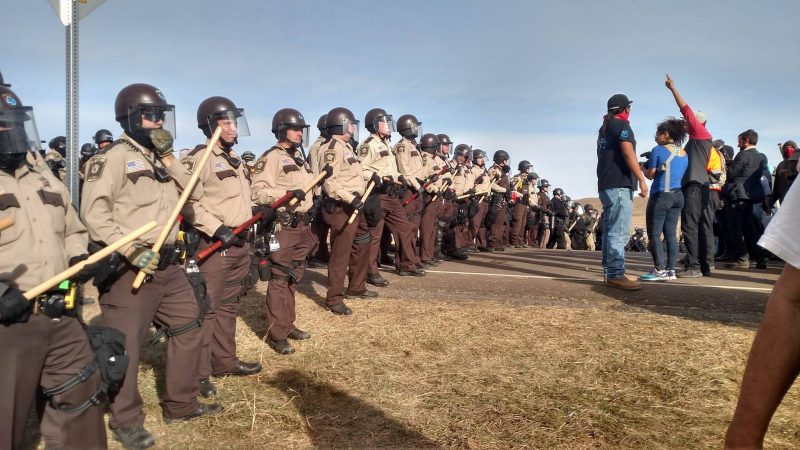
Later that night, a bridge on North Dakota Highway 1806, just north of the Red Warrior and Oceti Sakowin camps in Mandan, was the scene of another standoff between law enforcement and citizens opposed to the pipeline.
Although stationed on the water protectors’ side of the bridge, a small group of individuals did not seem to hold the same values or practice the same tactics as the larger, Native-led movement against the pipeline.
Watch “Water Protectors face off with police #NoDAPL” from MintPress News:
In stark contrast to the water protectors’ many actions of peaceful prayer and ceremony, the atmosphere at the bridge the night of Oct. 27 was more reminiscent of an outdoor rave. The protesters on the bridge set fire to an SUV, and threw rocks and other objects at a row of armored vehicles operated by law enforcement. This small faction of non-peaceful protesters and officers briefly tossed smoke bombs back and forth.
Officers eventually lit two smoke bombs on the north side of the bridge before parking two armored vehicles at the exit to the bridge, preventing water protectors and protestors from evacuating in that direction. All law enforcement vehicles were gone within a matter of minutes, and protesters climbed aboard the armored vehicles before setting fire to them.
When several water protectors came to the bridge, they told those setting the fires and instigating violence that this isn’t what they want for the movement.
“If you feel uncomfortable, if you don’t like this action, go back to camp,” one of the men shouted back at the water protectors.
Saying prayer had failed, the small group of non-peaceful protesters said they were now fighting “by any means necessary.”
The fires they set burned throughout the night, as neither law enforcement nor fire department personnel ever arrived at the scene to extinguish the flames.
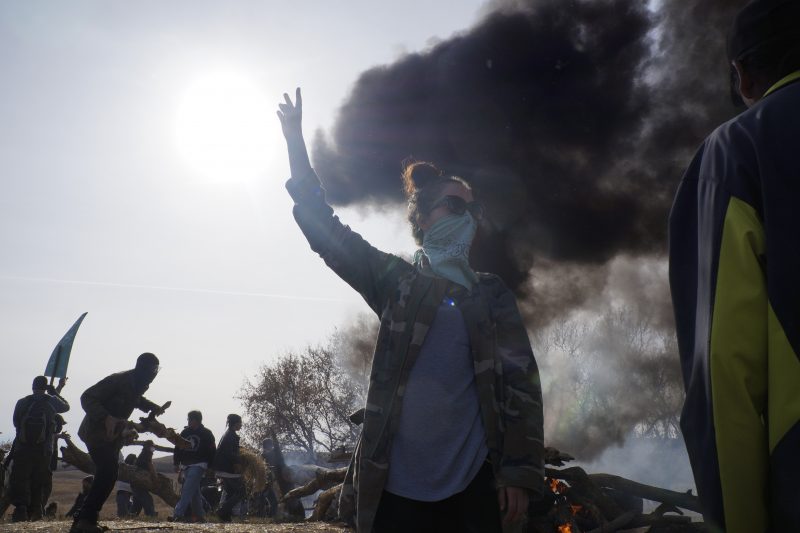
Agitators make their presence known
On Oct. 28, water protectors and elders arrived on the scene to retake the bridge from the agitating faction in all-black clothing, a tactic for protests and marches known as “black bloc.” There were no more than 20 of these provocateurs, and they all traveled together in five older pick-up trucks. Several fights broke out on the bridge as the agitators clashed with those calling strictly for prayer and ceremony, and the agitators were run off the bridge and back to the camps within an hour.
Siouxz, the head of security on the frontline camp off North Dakota Highway 1806, said those who started the fires were not with the water protector movement.
“Seven Council has came and they are very ashamed of the behavior of some of the non-traditional people here who can’t respect our ways and how we want to make this prayerful,” Siouxz told MintPress News.
“We’re here to protect the water, not initiate a riot or some violent protest, which is the image that the whole world is getting right now. Our elders have come together to condemn all of these wrongful actions like catching things on fire.”
Apparently intent on forcing their tactics upon the movement, these outside forces appeared uninterested in listening to the Standing Rock Sioux or other Native water protectors.
Although the black bloc tactic has been used as a legitimate way for protesters to shield their identities from law enforcement, it has also been exploited by law enforcement. Police masquerading as black bloc activists have been exposed at the 2001 G8 Summit in Genoa, Italy, and at protests in 2007 in Quebec, and police posed as activists to infiltrate the Occupy movement.
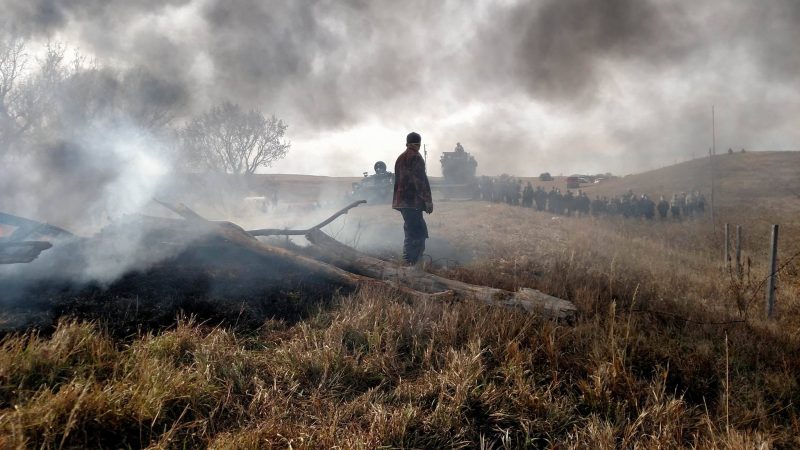
“Solidarity becomes the hijacking or destruction of competing movements, which is exactly what the Black Bloc contingents are attempting to do with the Occupy movement,” Chris Hedges, a progressive independent journalist and activist, wrote in a scathing criticism of the black bloc’s presence during the Occupy movement.
Law enforcement isn’t the only institution going undercover to infiltrate activist groups. Corporate entities also have a history of attempting to spy on peaceful, law-abiding activists. A 2013 report by the Center for Corporate Policy found that a large number of corporations are hiring former law enforcement, CIA, NSA, FBI, and military employees to act as spies.
In the report, titled “Spooky Business,” Gary Ruskin wrote:
“Many of the world’s largest corporations and their trade associations — including the U.S. Chamber of Commerce, Walmart, Monsanto, Bank of America, Dow Chemical, Kraft, Coca-Cola, Chevron, Burger King, McDonald’s, Shell, BP, BAE, Sasol, Brown & Williamson and E.ON — have been linked to espionage or planned espionage against nonprofit organizations, activists and whistleblowers.”
Considering what is known about corporate agitation, it is possible that the provocateurs were hired by Energy Transfer Partners, the company behind the pipeline, the banks financing the pipeline, or, really, any company that benefits from the pipeline in any way.
Ultimately, though, whether the agitators were police, corporate lackeys, or activists practicing a failed strategy, their actions do not represent the whole of the water protector movement and should not be used to discredit or delegitimize it.


